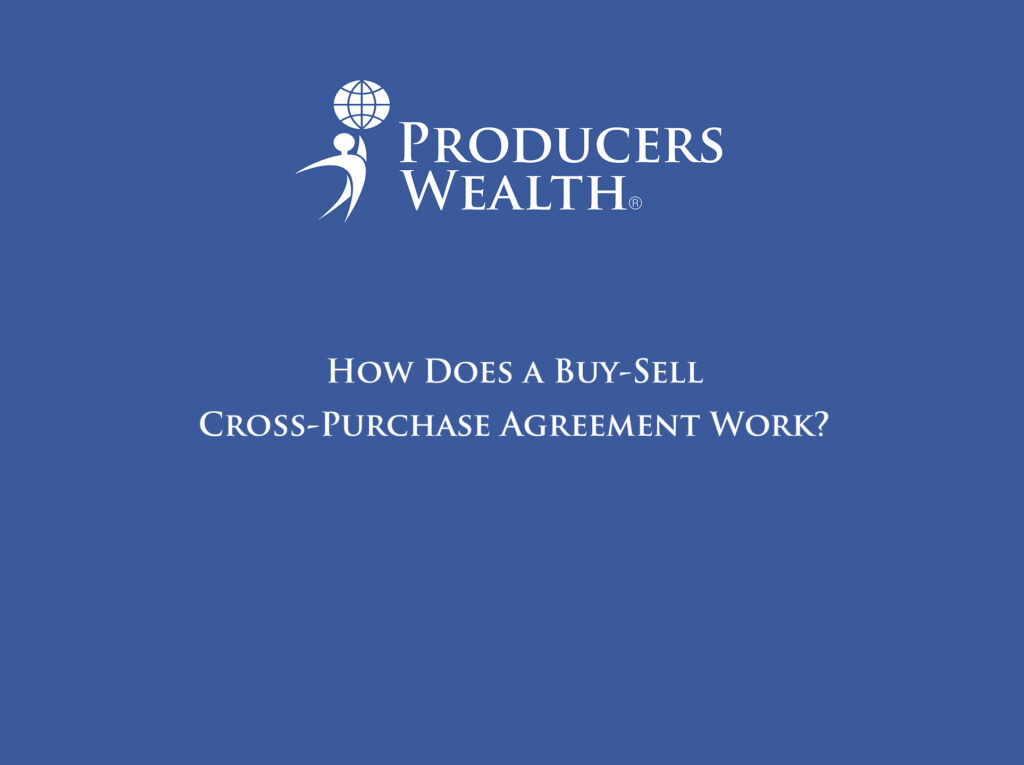
A buy-sell cross purchase agreement is a type of buy-sell agreement used among business co-owners to ensure a smooth transfer of ownership when one owner exits the business. This type of agreement is most commonly funded by life insurance and involves each business owner purchasing a life insurance policy on the other owners. When an owner dies, the surviving owners use the life insurance proceeds to buy out the deceased owner’s share in the business from their estate.
How Does a Buy-Sell Cross Purchase Agreement Work?
In a cross-purchase arrangement, each owner takes out a life insurance policy on the life of every other owner. Here’s a breakdown of how the process typically works:
- Purchasing Policies: Assume there are three co-owners (Owner A, Owner B, and Owner C). Each of these owners would take out a life insurance policy on the other two. So, Owner A owns policies on the lives of Owner B and Owner C, Owner B owns policies on the lives of Owner A and Owner C, and so on.
- Premium Payments: Each owner is responsible for paying the premiums on the policies they own. For example, Owner A would pay the premiums for the policies on Owner B and Owner C, while Owner B would pay for the policies on Owner A and Owner C.
- Event of Death: When one of the owners dies, the surviving owners receive the life insurance proceeds. They then use those proceeds to purchase the deceased owner’s share of the business from their estate.
- Transfer of Ownership: The surviving owners now own the business in proportion to their original shares plus the share they purchased from the deceased owner. This ensures that the business remains in the hands of the surviving owners and that the deceased owner’s family or estate is compensated.
Example of a Cross Purchase Agreement
Let’s consider a simple example with two co-owners, Jane and Bob, who each own 50% of a business:
- Jane owns a life insurance policy on Bob, and Bob owns a policy on Jane.
- Each policy is worth the value of the 50% ownership in the business.
- If Jane passes away, Bob receives the life insurance proceeds from the policy he owns on Jane’s life.
- Bob then uses the proceeds to buy out Jane’s 50% share from her estate.
- After the transaction, Bob now owns 100% of the business, and Jane’s estate has been fairly compensated for her share.
This structure ensures that the surviving business owner can buy out the deceased owner’s share without needing to use personal savings or secure financing. It also provides the deceased owner’s family with cash from the sale.
What Was the Connelly Court Ruling, and How Does a Cross Purchase Agreement Navigate Around It?
The Connelly court ruling relates to the tax treatment of life insurance policies and their impact on the basis of stock or ownership interests in a buy-sell agreement. Specifically, it addresses how the proceeds from a life insurance policy impact the valuation and basis adjustments for the remaining owners.
The key issue from the Connelly case is about basis adjustment when life insurance is used to fund a buy-sell agreement. Under previous interpretations, the life insurance proceeds received by a shareholder would not increase the basis in the shares they acquired. This could potentially create an undesirable tax situation for the surviving shareholders because when they later sell their shares, they might face significant capital gains taxes since their basis in the purchased shares would remain lower.
How Does a Cross Purchase Agreement Address the Issues Raised in the Connelly Ruling?
The cross-purchase strategy offers a way to sidestep the challenges presented by the Connelly decision because of how it handles ownership of life insurance policies and their proceeds:
- Direct Ownership of Life Insurance Policies: In a cross-purchase agreement, each owner directly owns the policy on the lives of other owners. This means that the insurance proceeds are paid directly to the surviving owners, not to the business itself. Because the proceeds are not being funneled through the company, they do not affect the company’s basis or create complications related to basis adjustments.
- Direct Basis Increase for Purchased Shares: When the surviving owners use the life insurance proceeds to purchase the deceased owner’s shares, they can adjust their cost basis in the newly acquired shares to the price they paid using the life insurance proceeds. This means that the surviving owners can increase their basis in the shares they purchased, which can help reduce capital gains taxes if they later sell their shares.
- Avoiding Corporate Alternative Minimum Tax (AMT): If a buy-sell arrangement is funded by policies owned by the business (as in a stock redemption plan), the proceeds can potentially affect the corporate tax status, especially concerning the AMT. However, in a cross-purchase agreement, the policies are held personally by the shareholders rather than the business, thus avoiding any impact on the company’s AMT calculations.
- Simplified Tax Treatment: A cross-purchase agreement keeps the tax treatment straightforward for the surviving owners. The life insurance proceeds they receive are generally income-tax-free, and they can use these proceeds to buy out the deceased owner’s interest without any impact on the business’s tax position. This is particularly advantageous in light of the Connelly ruling, which focused on how stock basis is treated in redemption-type buyouts.
Advantages of a Cross Purchase Buy-Sell Agreement
- Tax Efficiency: The ability to increase the basis in purchased shares helps reduce potential future capital gains taxes.
- Control and Flexibility: The surviving owners maintain control over the buyout process, ensuring the continuity of the business.
- Avoids Corporate Tax Implications: Since the business itself does not own the policies or receive the proceeds, there are fewer complications related to the company’s financials.
- Protection for Families: Provides a clear path for compensating the deceased owner’s family or estate, ensuring they receive the fair value of the ownership interest.
Disadvantages of a Cross Purchase Buy-Sell Agreement
- Number of Policies Needed: For businesses with multiple owners, a cross-purchase arrangement can become complicated, as each owner must hold a policy on each of the other owners. For example, with four owners, six policies are required.
- Premium Costs: The cost of maintaining life insurance policies can become significant, especially if the owners are of varying ages or health conditions.
- Administrative Complexity: Keeping track of multiple policies and ensuring that the ownership and beneficiary designations are correct can require meticulous attention to detail.
Using a Cross Purchase Strategy Post-Connelly
The Connelly court ruling brought to light some complexities in the tax treatment of life insurance-funded buy-sell agreements. For business owners concerned about maintaining control over their tax basis in the event of a buyout, a cross-purchase buy-sell agreement provides an effective solution. By ensuring that life insurance policies are personally owned and used directly to purchase shares, this arrangement can navigate the basis adjustment issues raised in Connelly.
For businesses with a smaller number of owners, the cross-purchase agreement is often a preferred method, offering tax advantages and ensuring a smoother transition of ownership. However, it is essential to weigh the administrative complexity and premium costs against the benefits. As with any estate or succession planning strategy, it’s critical to consult with legal and financial advisors to design a plan that aligns with the specific needs and goals of the business and its owners.e tool for those who need a way to preserve wealth while providing for loved ones. By understanding its benefits and limitations, you can make an informed decision and create a legacy that reflects your values and priorities.
Watch all of our educational videos on Infinite Banking here.
Disclaimer and Waiver
Michiel Laubscher & Laubscher Wealth Management LLC is not an investment advisor and is not licensed to sell securities. None of the information provided is intended as investment, tax, accounting, or legal advice, as an offer or solicitation of an offer to buy or sell, or as an endorsement, of any company, security, fund, or other offerings. The information should not be relied upon for purposes of transacting securities or other investments. Your use of the information contained herein is at your own risk. The content is provided ‘as is’ and without warranties, either expressed or implied. Michiel Laubscher & Laubscher Wealth Management LLC does not promise or guarantee any income or specific result from using the information contained herein and is not liable for any loss or damage caused by your reliance on the information contained herein. Always seek the advice of professionals, as appropriate, regarding the evaluation of any specific information, opinion, or other content.





